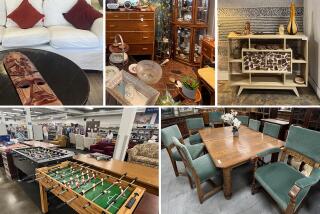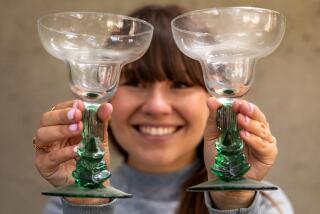COLLECTIBLES : Buy Antiques Cheap<i> --Then</i> Fall in Love
- Share via
You can invest in collectibles and antiques for both fun and profit.
“The ideal situation is to buy something you love, have it in your home for 15 or 20 years, and then sell it at a profit,” said Robert Brunk, owner of Brunk’s Auctions in Asheville, N.C.
“How much you invest in antiques has to do with your risk factor, how much it matters to you if what you buy does not turn out to be a good investment. If an antique brings you joy and mystery and satisfies your aesthetic needs, the monetary aspect may or may not be important.”
Author and appraisal expert Emyl Jenkins agreed, saying: “Buying what you like is still good advice, for you need passion and interest to become an expert in any field. You’ll never become an expert, you’ll never develop a trained eye, if you don’t have a passion for what you collect.”
Harry Rinker, columnist and lecturer, advised: “Buy it cheap, then fall in love with it.”
Just as there are varieties of stocks, so there are various types of investment in antiques. Antiques with an established audience, such as 18th- and 19th-Century furniture, silver and porcelain, experienced their dramatic market climbs years ago. Now prices are relatively stable, not unlike blue-chip stocks. Careful investments in traditional antiques rarely lose money.
Investing in an expanding field is like investing in a new company. You can enter the market with only a few dollars, but the risk factor is high. Collectibles sometimes make a strong run at first, then drop sharply. Anyone who invested heavily in 1960s lunch boxes and cookie jars can describe the sickening feeling of watching an investment plummet in value.
Here are some rules for investing in antiques and collectibles:
* Pick one category and specialize in it. The category must appeal not only to you but to a broad range of fellow buyers, because the time will come when you will want to sell. Read everything written about your category, study every example you can find, track auction records and record your findings.
* Be aware of market influences. Major museum exhibitions and new books can trigger price jumps. Those aware of the 1972 Princeton, N.J., exhibition “The Arts & Crafts Movement in America” and who invested $10,000 in Gustav Stickley chairs or Dirk van Erp lamps, could have watched their investment’s worth multiply more than tenfold within 20 years.
* Buy the best. “Whatever you like,” Brunk advised, “buy the very best examples. You will pay more, but you’ll have a better chance of really improving your investments.”
* Recognize fakes and reproductions. When antiques attain a certain value, reproductions follow. Two fields plagued by fakes are Tiffany lamps and mechanical banks.
* Seek professional advice. “If you are going to invest large sums of money,” Brunk said, “you need the help of an honest professional--be it an antiques dealer, curator or another collector--because at this level, knowledge is money.”
* Discipline yourself. Buying antiques strictly as investments requires emotional detachment. No antique can be considered a true investment unless you intend to sell it. Set a deadline or a price threshold for selling. And be prepared to sell.
“The problem,” Rinker says, “is that most people wait too long before they sell. The market peaks, and they hang on to their stuff. Then, when they need the cash, demand has dropped.”
More to Read
Sign up for The Wild
We’ll help you find the best places to hike, bike and run, as well as the perfect silent spots for meditation and yoga.
You may occasionally receive promotional content from the Los Angeles Times.






